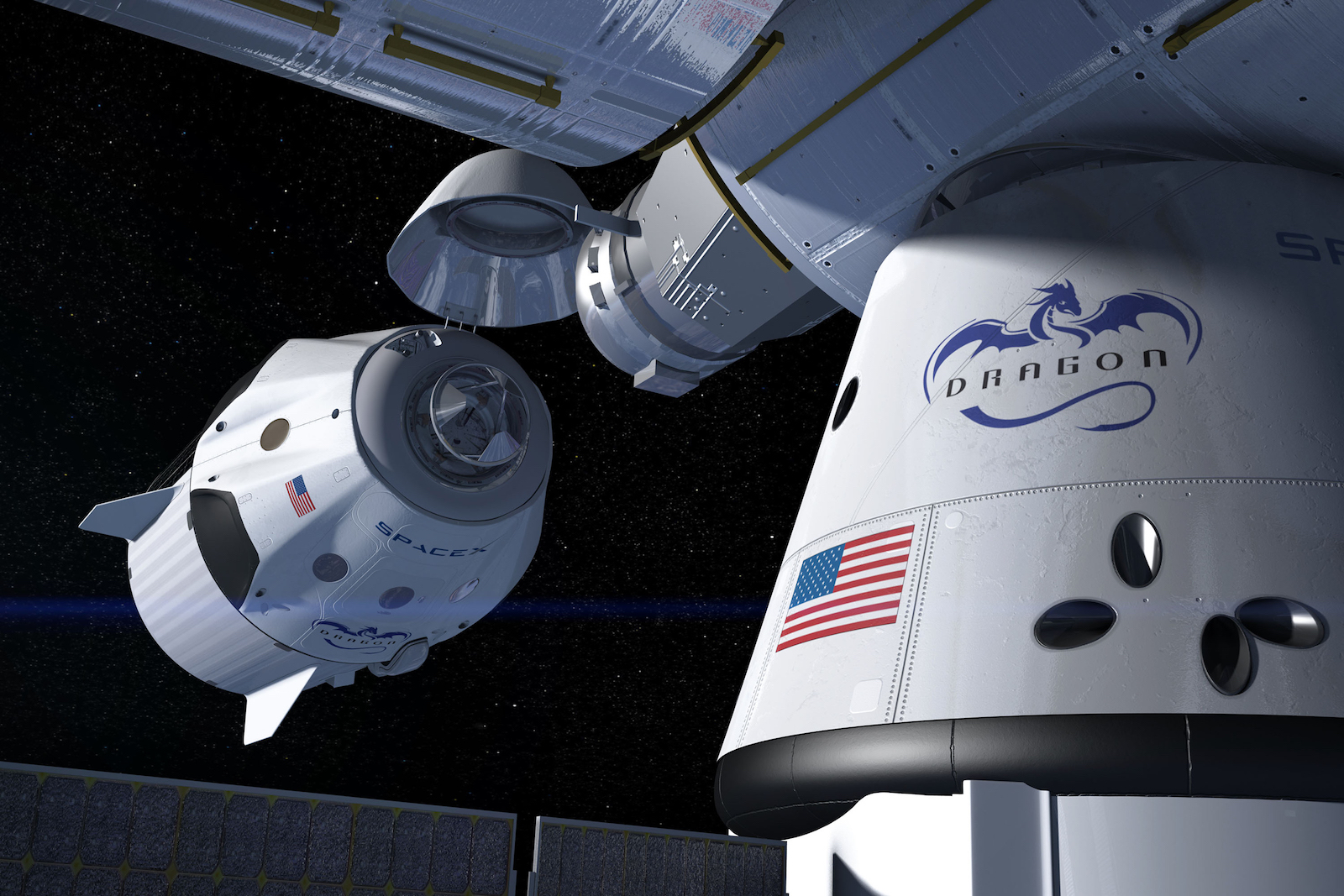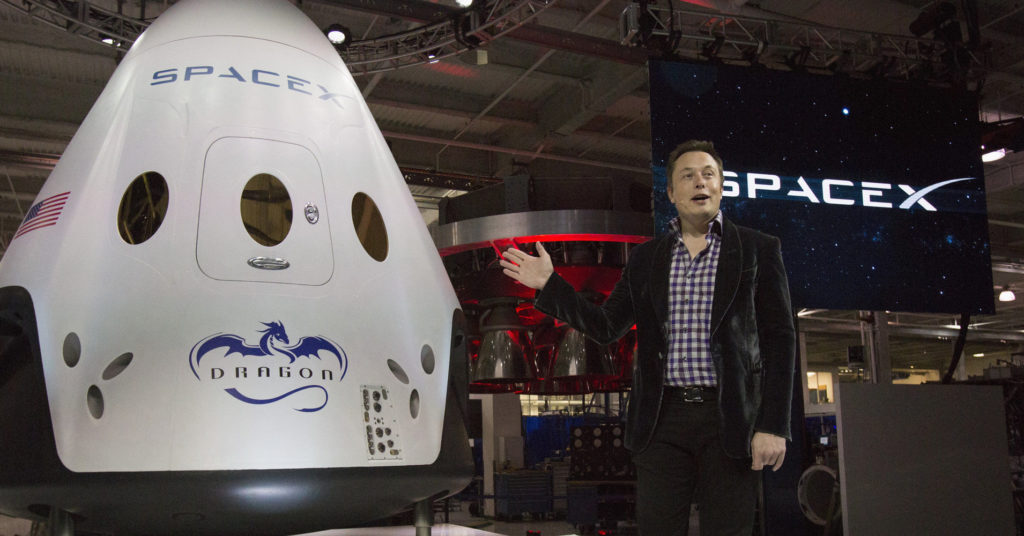

News
SpaceX preparing Dragon 2 for Feb. 2018 launch, progressing Dragon 1 reuse efforts
NASA has released tentative flight schedules for the first Commercial Crew Program missions of Boeing and SpaceX, aligning with recent suggestions that SpaceX’s schedule had slipped by several months. SpaceX’s first Commercial Crew mission, an uncrewed inaugural test of Dragon 2, has moved from late 2017 into early 2018, and is now targeting a launch no earlier than February.
Presenting at the 2017 ISS R&D Conference in D.C. earlier this week, chief Elon Musk reiterated that SpaceX was laser-focused on doing everything possible to ensure that Falcon 9 and Dragon 2 are as reliable and safe as can be. The company’s first crewed launch is subsequently planned for no earlier than June 2018, under the condition of a nominal demonstration flight of Dragon 2 four months prior. The choice to end development of propulsive landing of Dragon 2 will likely help the company more easily meet their schedule goals.
During the same talk, Musk took time to address what he considered a missed opportunity, SpaceX’s historic reuse of a Dragon spacecraft with the launch of NASA’s CRS-11 mission in June. In Musk’s opinion, SpaceX should have taken the opportunity to promote the genuinely unique and difficult accomplishment. He certainly isn’t wrong. To paraphrase, a private company conducted the first orbital reuse of a spacecraft since the Space Shuttle retired in 2011, and also became one of only three other orbital vehicles to have ever flown to orbit more than once.

SpaceX CEO Elon Musk speaks after unveiling the Dragon V2 spacecraft in Hawthorne, California May 29, 2014. Photo: REUTERS/Mario Anzuoni
Furthermore, SpaceX has suggested for quite some time that the company was planning on ending the manufacture of Dragon 1 pressure vessels in order to retool the assembly line and begin fully focusing on Dragon 2 manufacturing. Recent persistent rumors would seem to suggest that this may have already occurred, or is at least very close to occurring. SpaceX is likely to benefit considerably by exploiting the opportunity they have to refurbish and reuse orbital spacecraft, and it is likely that a majority of the nine cargo missions left in its first CRS contract will be conducted with refurbished Dragon capsules.
Of course, a great deal of the capsule must be replaced with new parts as a result of ocean landings, but Musk said he expects the next Dragon reuse and all future reuses to save the SpaceX nearly 50% of the cost of manufacturing an entirely new spacecraft. Musk admitted that the first refurbishment of Dragon likely ended up costing as much or more than a new vehicle, but this is to be expected for the first attempt to reuse any sort of space hardware that must survive some form of reentry heating and saltwater immersion.
Throughout the discussion, Elon Musk frequently and wholeheartedly praised NASA for enabling SpaceX to exist and to remain the agile aerospace company it wants to be while still working as a private partner of the agency. It is indeed exceptional that NASA’s CRS team has allowed SpaceX to upgrade and iterate Falcon 9 and Dragon hardware and procedures, with NASA expressing an uncharacteristic level of flexibility by permitting the many small additional risks the constant state of flux of SpaceX’s hardware has inevitably introduced.
Musk went so far as to state flat-out that Bill Gerstenmaier, NASA’s longstanding head of manned spaceflight, was “one of [his] favorite people in the world”. SpaceX and Musk’s consistent willingness to publicly thank and praise NASA has been an exception to the norm of the aerospace industry, and SpaceX and NASA will undoubtedly continue their strong relationship well into the future.
News
Tesla begins Robotaxi certification push in Arizona: report
Tesla seems serious about expanding its Robotaxi service to several states in the coming months.

Tesla has initiated discussions with Arizona transportation regulators to certify its driverless Robotaxi service in the state, as per a recent report from Bloomberg News. The move follows Tesla’s launch of its Robotaxi pilot program in Austin, Texas, as well as CEO Elon Musk’s recent comments about the service’s expansion in the Bay Area.
The Arizona Department of Transportation confirmed to Bloomberg that Tesla has reached out to begin the certification process for autonomous ride-sharing operations in the state. While details remain limited, the outreach suggests that Tesla is serious about expanding its driverless Robotaxi service to several territories in the coming months.
The Arizona development comes as Tesla prepares to expand its service area in Austin this weekend, as per CEO Elon Musk in a post on X. Musk also stated that Tesla is targeting the San Francisco Bay Area as its next major market, with a potential launch “in a month or two,” pending regulatory approvals.
Tesla first launched its autonomous ride-hailing program on June 22 in Austin with a small fleet of Model Y vehicles, accompanied by a Tesla employee in the passenger seat to monitor safety. While still classified as a test, Musk has said the program will expand to about 1,000 vehicles in the coming months. Tesla will later upgrade its Robotaxi fleet with the Cyercab, a two-seater that is designed without a steering wheel.
Sightings of Cybercab castings around the Giga Texas complex suggests that Tesla may be ramping the initial trial production of the self-driving two-seater. Tesla, for its part, has noted in the past that volume production of the Cybercab is expected to start sometime next year.
In California, Tesla has already applied for a transportation charter-party carrier permit from the state’s Public Utilities Commission. The company is reportedly taking a phased approach to operating in California, with the Robotaxi service starting with pre-arranged rides for employees in vehicles with safety drivers.
News
Tesla sets November 6 date for 2025 Annual Shareholder Meeting
The automaker announced the date on Thursday in a Form 8-K.

Tesla has scheduled its 2025 annual shareholder meeting for November 6, addressing investor concerns that the company was nearing a legal deadline to hold the event.
The automaker announced the date on Thursday in a Form 8-K submitted to the United States Securities and Exchange Commission (SEC). The company also listed a new proposal submission deadline of July 31 for items to be included in the proxy statement.
Tesla’s announcement followed calls from a group of 27 shareholders, including the leaders of large public pension funds, which urged Tesla’s board to formally set the meeting date, as noted in a report from The Wall Street Journal.
The group noted that under Texas law, where Tesla is now incorporated, companies must hold annual meetings within 13 months of the last one if requested by shareholders. Tesla’s previous annual shareholder meeting was held on June 13, 2024, which placed the July 13 deadline in focus.
Tesla originally stated in its 2024 annual report that it would file its proxy statement by the end of April. However, an amended filing on April 30 indicated that the Board of Directors had not yet finalized a meeting date, at least at the time.
The April filing also confirmed that Tesla’s board had formed a special committee to evaluate certain matters related to CEO Elon Musk’s compensation plan. Musk’s CEO performance award remains at the center of a lengthy legal dispute in Delaware, Tesla’s former state of incorporation.
Due to the aftermath of Musk’s legal dispute about his compensation plan in Delaware, he has not been paid for his work at Tesla for several years. Musk, for his part, has noted that he is more concerned about his voting stake in Tesla than his actual salary.
At last year’s annual meeting, TSLA shareholders voted to reapprove Elon Musk’s compensation plan and ratified Tesla’s decision to relocate its legal domicile from Delaware to Texas.
Elon Musk
Grok coming to Tesla vehicles next week “at the latest:” Elon Musk
Grok’s rollout to Tesla vehicles is expected to begin next week at the latest.

Elon Musk announced on Thursday that Grok, the large language model developed by his startup xAI, will soon be available in Tesla vehicles. Grok’s rollout to Tesla vehicles is expected to begin next week at the latest, further deepening the ties between the two Elon Musk-led companies.
Tesla–xAI synergy
Musk confirmed the news on X shortly after livestreaming the release of Grok 4, xAI’s latest large language model. “Grok is coming to Tesla vehicles very soon. Next week at the latest,” Musk wrote in a post on social media platform X.
During the livestream, Musk and several members of the xAI team highlighted several upgrades to Grok 4’s voice capabilities and performance metrics, positioning the LLM as competitive with top-tier models from OpenAI and Google.
The in-vehicle integration of Grok marks a new chapter in Tesla’s AI development. While Tesla has long relied on in-house systems for autonomous driving and energy optimization, Grok’s integration would introduce conversational AI directly into its vehicles’ user experience. This integration could potentially improve customer interaction inside Tesla vehicles.
xAI and Tesla’s collaborative footprint
Grok’s upcoming rollout to Tesla vehicles adds to a growing business relationship between Tesla and xAI. Earlier this year, Tesla disclosed that it generated $198.3 million in revenue from commercial, consulting, and support agreements with xAI, as noted in a report from Bloomberg News. A large portion of that amount, however, came from the sale of Megapack energy storage systems to the artificial intelligence startup.
In July 2023, Musk polled X users about whether Tesla should invest $5 billion in xAI. While no formal investment has been made so far, 68% of poll participants voted yes, and Musk has since stated that the idea would be discussed with Tesla’s board.
-

 Elon Musk1 week ago
Elon Musk1 week agoTesla investors will be shocked by Jim Cramer’s latest assessment
-

 Elon Musk18 hours ago
Elon Musk18 hours agoxAI launches Grok 4 with new $300/month SuperGrok Heavy subscription
-

 Elon Musk3 days ago
Elon Musk3 days agoElon Musk confirms Grok 4 launch on July 9 with livestream event
-

 News7 days ago
News7 days agoTesla Model 3 ranks as the safest new car in Europe for 2025, per Euro NCAP tests
-

 Elon Musk2 weeks ago
Elon Musk2 weeks agoA Tesla just delivered itself to a customer autonomously, Elon Musk confirms
-

 Elon Musk1 week ago
Elon Musk1 week agoxAI’s Memphis data center receives air permit despite community criticism
-

 Elon Musk2 weeks ago
Elon Musk2 weeks agoTesla’s Omead Afshar, known as Elon Musk’s right-hand man, leaves company: reports
-

 News2 weeks ago
News2 weeks agoXiaomi CEO congratulates Tesla on first FSD delivery: “We have to continue learning!”













